Omron 3G3JX User Manual
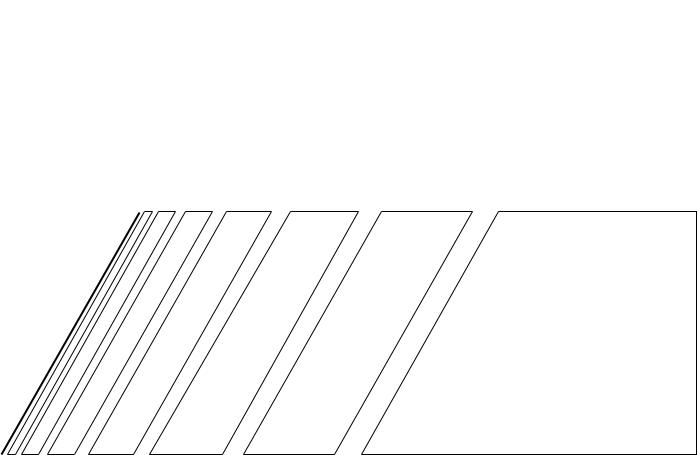
Cat. No. I558-E1-02
USER’S MANUAL
SYSDRIVE JXSERIES
Compact Simplified Inverters

Introduction
Introduction
Thank you for choosing the general-purpose Inverter 3G3JX. This User's Manual (hereinafter called "this manual") describes the parameter setting methods required for installation/wiring and operation of the 3G3JX model, as well as troubleshooting and inspection methods.
zThis manual should be delivered to the actual end user of the product.
zAfter reading this manual, keep it handy for future reference.
zThis manual describes the specifications and functions of the product as well as the relations between them. You should assume that anything not described in this manual is not possible with the product.
zIntended readers
This manual is intended for:
Those with knowledge of electrical systems (qualified electrical engineers or the equivalent), and also in charge of:
•Introducing the control equipment
•Designing the control system
•Installing and/or connecting the control equipment
•Field management
1
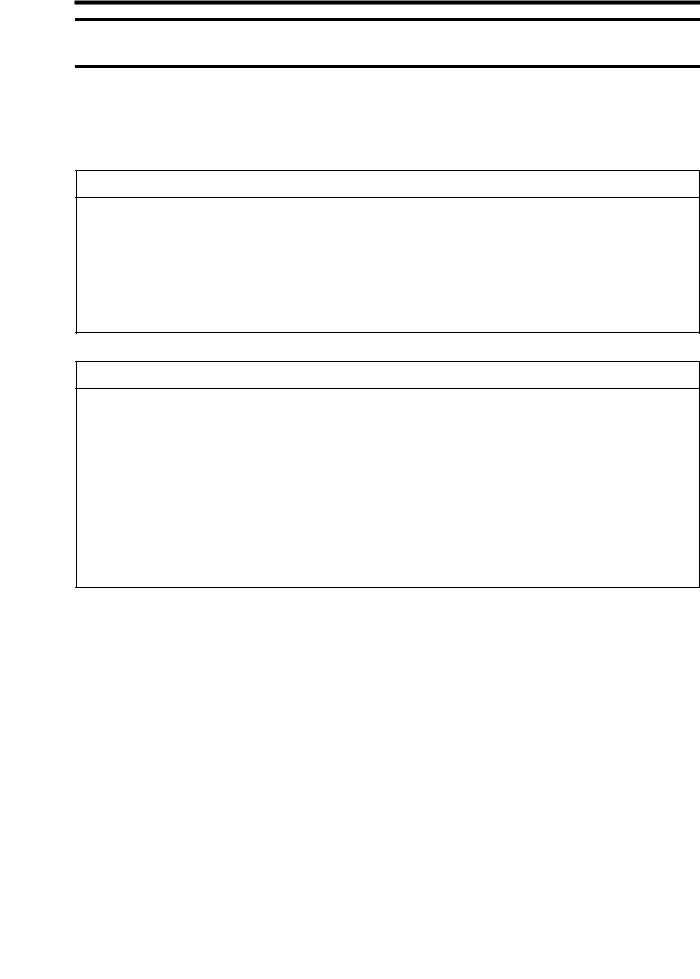
Read and Understand This Manual
Read and Understand This Manual
Please read and understand this manual before using the product. Please consult your OMRON representative if you have any questions or comments.
Warranty and Limitations of Liability
WARRANTY
OMRON's exclusive warranty is that the products are free from defects in materials and workmanship for a period of one year (or other period if specified) from date of sale by OMRON.
OMRON MAKES NO WARRANTY OR REPRESENTATION, EXPRESS OR IMPLIED, REGARDING NON-INFRINGEMENT, MERCHANTABILITY, OR FITNESS FOR PARTICULAR PURPOSE OF THE PRODUCTS. ANY BUYER OR USER ACKNOWLEDGES THAT THE BUYER OR USER ALONE HAS DETERMINED THAT THE PRODUCTS WILL SUITABLY MEET THE REQUIREMENTS OF THEIR INTENDED USE. OMRON DISCLAIMS ALL OTHER WARRANTIES, EXPRESS OR IMPLIED.
LIMITATIONS OF LIABILITY
OMRON SHALL NOT BE RESPONSIBLE FOR SPECIAL, INDIRECT, OR CONSEQUENTIAL DAMAGES, LOSS OF PROFITS OR COMMERCIAL LOSS IN ANY WAY CONNECTED WITH THE PRODUCTS, WHETHER SUCH CLAIM IS BASED ON CONTRACT, WARRANTY, NEGLIGENCE, OR STRICT LIABILITY.
In no event shall the responsibility of OMRON for any act exceed the individual price of the product on which liability is asserted.
IN NO EVENT SHALL OMRON BE RESPONSIBLE FOR WARRANTY, REPAIR, OR OTHER CLAIMS REGARDING THE PRODUCTS UNLESS OMRON'S ANALYSIS CONFIRMS THAT THE PRODUCTS WERE PROPERLY HANDLED, STORED, INSTALLED, AND MAINTAINED AND NOT SUBJECT TO CONTAMINATION, ABUSE, MISUSE, OR INAPPROPRIATE MODIFICATION OR REPAIR.
2
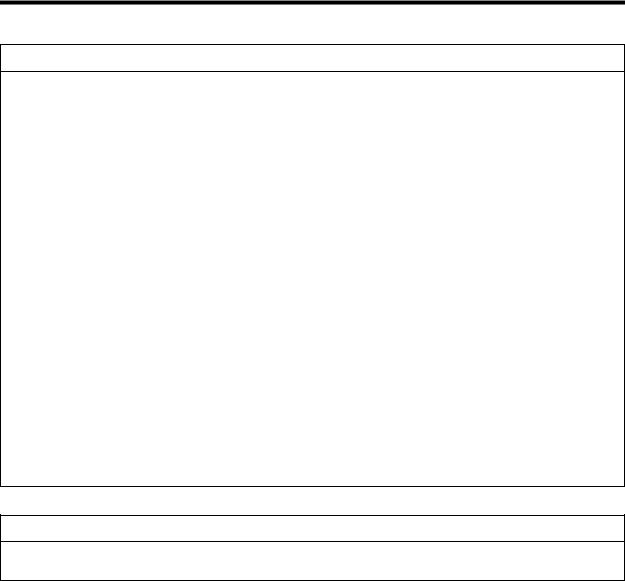
Read and Understand This Manual
Application Considerations
SUITABILITY FOR USE
OMRON shall not be responsible for conformity with any standards, codes, or regulations that apply to the combination of products in the customer's application or use of the products.
At the customer's request, OMRON will provide applicable third party certification documents identifying ratings and limitations of use that apply to the products. This information by itself is not sufficient for a complete determination of the suitability of the products in combination with the end product, machine, system, or other application or use.
The following are some examples of applications for which particular attention must be given. This is not intended to be an exhaustive list of all possible uses of the products, nor is it intended to imply that the uses listed may be suitable for the products:
•Outdoor use, uses involving potential chemical contamination or electrical interference, or conditions or uses not described in this manual.
•Nuclear energy control systems, combustion systems, railroad systems, aviation systems, medical equipment, amusement machines, vehicles, safety equipment, and installations subject to separate industry or government regulations.
•Systems, machines, and equipment that could present a risk to life or property.
Please know and observe all prohibitions of use applicable to the products.
NEVER USE THE PRODUCTS FOR AN APPLICATION INVOLVING SERIOUS RISK TO LIFE OR PROPERTY WITHOUT ENSURING THAT THE SYSTEM AS A WHOLE HAS BEEN DESIGNED TO ADDRESS THE RISKS, AND THAT THE OMRON PRODUCTS ARE PROPERLY RATED AND INSTALLED FOR THE INTENDED USE WITHIN THE OVERALL EQUIPMENT OR SYSTEM.
PROGRAMMABLE PRODUCTS
OMRON shall not be responsible for the user's programming of a programmable product, or any consequence thereof.
3
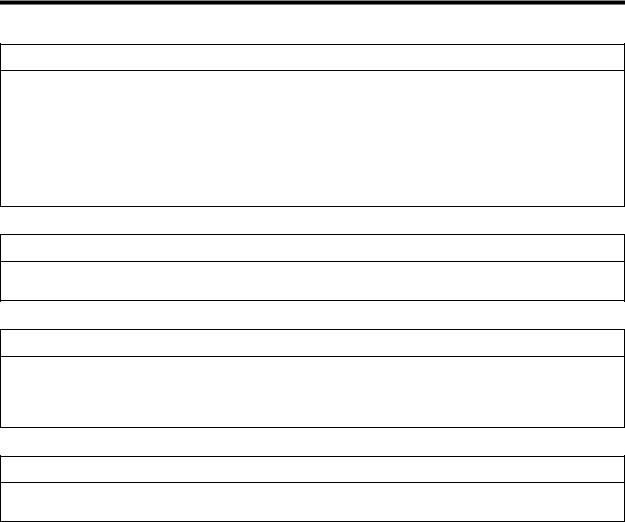
Read and Understand This Manual
Disclaimers
CHANGE IN SPECIFICATIONS
Product specifications and accessories may be changed at any time based on improvements and other reasons.
It is our practice to change model numbers when published ratings or features are changed, or when significant construction changes are made. However, some specifications of the products may be changed without any notice. When in doubt, special model numbers may be assigned to fix or establish key specifications for your application on your request. Please consult with your OMRON representative at any time to confirm actual specifications of purchased products.
DIMENSIONS AND WEIGHTS
Dimensions and weights are nominal and are not to be used for manufacturing purposes, even when tolerances are shown.
PERFORMANCE DATA
Performance data given in this manual is provided as a guide for the user in determining suitability and does not constitute a warranty. It may represent the result of OMRON's test conditions, and the users must correlate it to actual application requirements. Actual performance is subject to the OMRON Warranty and Limitations of Liability.
ERRORS AND OMISSIONS
The information in this manual has been carefully checked and is believed to be accurate; however, no responsibility is assumed for clerical, typographical, or proofreading errors, or omissions.
4
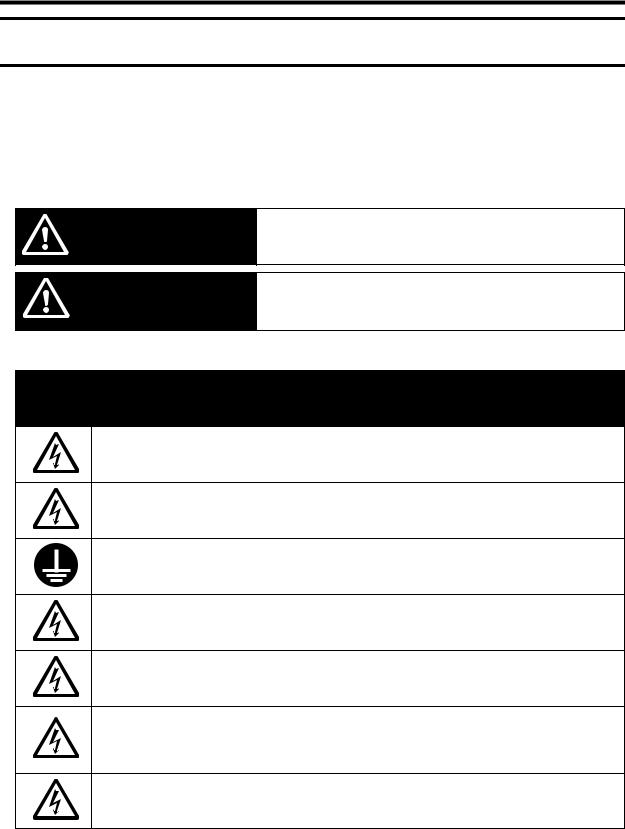
Safety Precautions
Safety Precautions
Indications and Meanings of Safety Information
In this user's manual, the following precautions and signal words are used to provide information to ensure the safe use of the 3G3JX Inverter.
The information provided here is vital to safety. Strictly observe the precautions provided.
Meanings of Signal Words
Indicates an imminently hazardous situation which, if not avoided, WARNING is likely to result in serious injury or may result in death. Additionally
there may be severe property damage.
CAUTION |
Indicates a potentially hazardous situation which, if not avoided, |
may result in minor or moderate injury or in property damage. |
Alert Symbols in This Document
 WARNING
WARNING
Turn off the power supply and implement wiring correctly. Not doing so may result in a serious injury due to an electric shock.
Wiring work must be carried out only by qualified personnel. Not doing so may result in a serious injury due to an electric shock.
Be sure to ground the unit. Not doing so may result in a serious injury due to an electric shock or fire.
(200-V class: type-D grounding, 400-V class: type-C grounding)
Do not remove the front cover during the power supply and 5 minutes after the power shutoff. Doing so may result in a serious injury due to an electric shock.
Do not operate the Digital Operator or switches with wet hands. Doing so may result in a serious injury due to an electric shock.
Inspection of the Inverter must be conducted after the power supply has been turned off. Not doing so may result in a serious injury due to an electric shock.
The main power supply is not necessarily shut off even if the emergency shutoff function is activated.
Do not change wiring, mode change switches (S7, S8), optional devices or replace cooling fans while the input power is being supplied.
Doing so may result in a serious injury due to an electric shock.
5
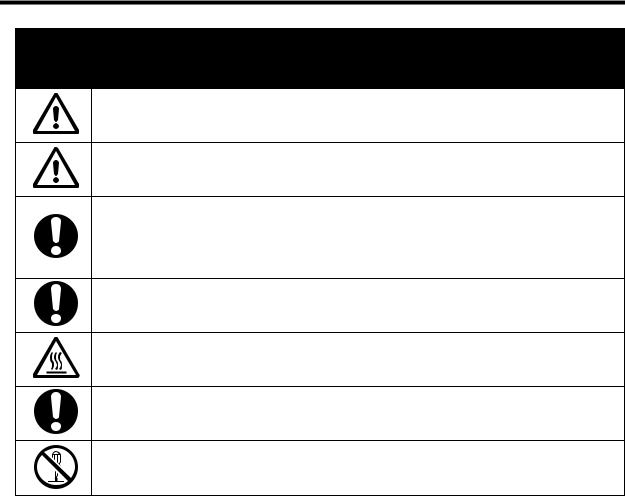
Safety Precautions
 CAUTION
CAUTION
Do not connect resistors to the terminals (+1, P/+2, N/-) directly.
Doing so might result in a small-scale fire, heat generation or damage to the unit.
Install a stop motion device to ensure safety. Not doing so might result in a minor injury. (A holding brake is not a stop motion device designed to ensure safety.)
Be sure to use a specified type of braking resistor/regenerative braking unit. In case of a braking resistor, install a thermal relay that monitors the temperature of the resistor. Not doing so might result in a moderate burn due to the heat generated in the braking resistor/regenerative braking unit. Configure a sequence that enables the Inverter power to turn off when unusual overheating is detected in the braking resistor/regenerative braking unit.
The Inverter has high voltage parts inside which, if short-circuited, might cause damage to itself or other property. Place covers on the openings or take other precautions to make sure that no metal objects such as cutting bits or lead wire scraps go inside when installing and wiring.
Do not touch the Inverter fins, braking resistors and the motor, which become too hot during the power supply and for some time after the power shutoff. Doing so may result in a burn.
Take safety precautions such as setting up a molded-case circuit breaker (MCCB) that matches the Inverter capacity on the power supply side. Not doing so might result in damage to property due to the short circuit of the load.
Do not dismantle, repair or modify the product.
Doing so may result in an injury.
6

Precautions for Safe Use
Precautions for Safe Use
Installation and Storage
Do not store or use the product in the following places. •Locations subject to direct sunlight.
•Locations subject to ambient temperature exceeding the specifications. •Locations subject to relative humidity exceeding the specifications. •Locations subject to condensation due to severe temperature fluctuations. •Locations subject to corrosive or flammable gases.
•Locations subject to exposure to combustibles. •Locations subject to dust (especially iron dust) or salt. •Locations subject to exposure to water, oil, or chemicals. •Locations subject to shock or vibration.
Transporting, Installation, and Wiring
•Do not drop or apply a strong impact on the product. Doing so may result in damaged parts or malfunction. •Do not hold by the front cover, but hold by the fins during transportation.
•Do not connect an AC power supply voltage to the control input/output terminals. Doing so may result in damage to the product.
•Be sure to tighten the screws on the terminal block securely. Wiring work must be done after installing the unit body.
•Do not connect any load other than a three-phase inductive motor to the U, V, and W output terminals. •Take sufficient shielding measures when using the product in the following locations. Not doing so may result in damage to the product.
Locations subject to static electricity or other forms of noise. Locations subject to strong magnetic fields.
Locations close to power lines.
Operation and Adjustment
•Be sure to confirm the permissible range of motors and machines before operation because the Inverter speed can be changed easily from low to high.
•Provide a separate holding brake if necessary.
Maintenance and Inspection
•Be sure to confirm safety before conducting maintenance, inspection or parts replacement.
7
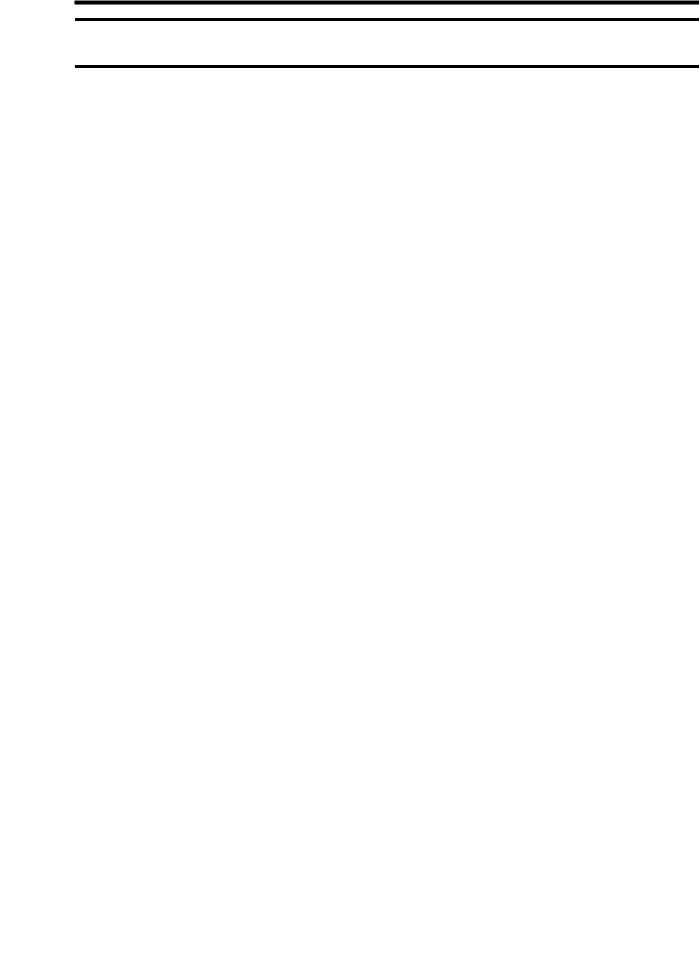
Precautions for Correct Use
Precautions for Correct Use
Installation
•Mount the product vertically on a wall or on a DIN track (optional) with the product's longer sides upright. The material of the wall has to be nonflammable such as a metal plate.
Main Circuit Power Supply
•Confirm that the rated input voltage of the Inverter is the same as AC power supply voltage.
Error Retry Function
•Do not come close to the machine when using the error retry function because the machine may abruptly start when stopped by an alarm.
•Be sure to confirm the RUN signal is turned off before resetting the alarm because the machine may abruptly start.
Non-Stop Function at Momentary Power Interruption
•Do not come close to the machine when selecting restart in the non-stop function at momentary power interruption selection (b050) because the machine may abruptly start after the power is turned on.
Operation Stop Command
•Provide a separate emergency stop switch because the STOP key on the Digital Operator is valid only when function settings are performed.
•When checking a signal during the power supply and the voltage is erroneously applied to the control input terminals, the motor may start abruptly. Be sure to confirm safety before checking a signal.
Product Disposal
•Comply with the local ordinance and regulations when disposing of the product.
8
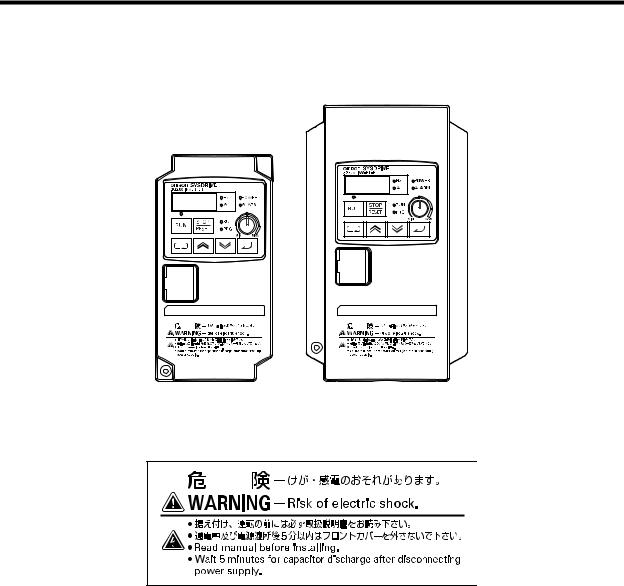
Precautions for Correct Use
Warning Labels
Warning labels are located on the Inverter as shown in the following illustration.
Be sure to follow the instructions.
Warning Description
9
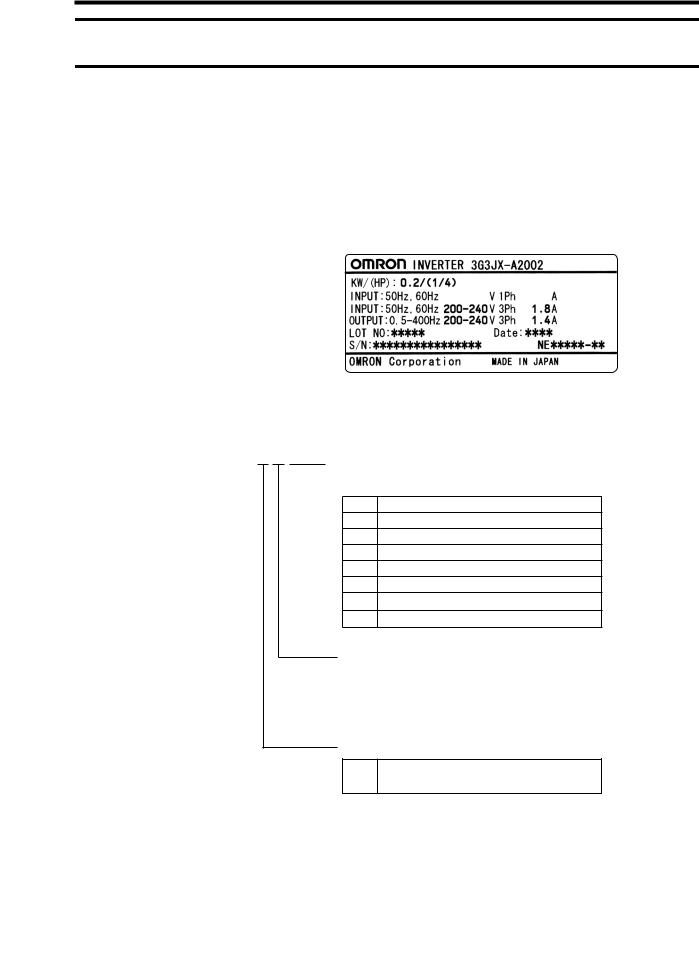
Checking Before Unpacking
Checking Before Unpacking
Checking the Product
On delivery, be sure to check that the delivered product is the Inverter 3G3JX model that you ordered.
Should you find any problems with the product, immediately contact your nearest local sales representative or OMRON sales office.
zChecking the Nameplate
Inverter model 
Input specifications 
Output specifications 
zChecking the Model
3 G 3 J X - A 2 0 0 2
 Maximum applicable motor capacity
Maximum applicable motor capacity
002 0.2 kW
004 0.4 kW
007 0.75 kW
015 1.5 kW
022 2.2 kW
037 3.7 kW
055 5.5 kW
075 7.5 kW
Voltage class
2 |
3-phase 200 V AC (200-V class) |
E |
1/3-phase 200 V AC (200-V class) |
4 |
3-phase 400 V AC (400-V class) |
Enclosure rating
A
Panel-mounting (IP10 min.) or closed wall-mounting models
Checking the Accessories
Note that this manual is the only accessory included with the 3G3JX model. Mounting screws and other necessary parts must be provided by the user.
10
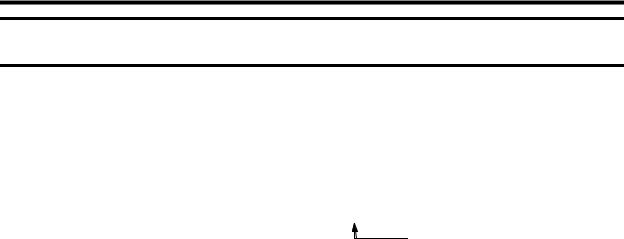
Revision History
Revision History
A manual revision code appears as a suffix to the catalog number located at the lower left of the front and back covers.
Cat. No. I558-E1-02
Revision code
Revision code |
Revision date |
Changes and revision pages |
|
|
|
|
|
01 |
December 2007 |
First printing |
|
|
|
|
|
|
|
New Inverters with different capacities added (3G3JX- |
|
|
|
A2055/-A2075/-A4055/-A4075) |
|
|
|
New functions added for with 5.5-/7.5-kW Inverters |
|
02 |
April 2008 |
Manual descriptions improved and/or corrected |
|
Page10, Page 1-1, Page 1-2, Page 2-2, Page 2-8, Page 2- |
|||
|
|
||
|
|
13, Page 2-14, Page 2-15, Page 2-16, Pages 4-77 to 4- |
|
|
|
104, Page 7-1, Page 7-2, Page 7-6, Page 7-18, Page 7-20, |
|
|
|
Page 7-26, Page 7-27, Page 7-30 |
|
|
|
|
11
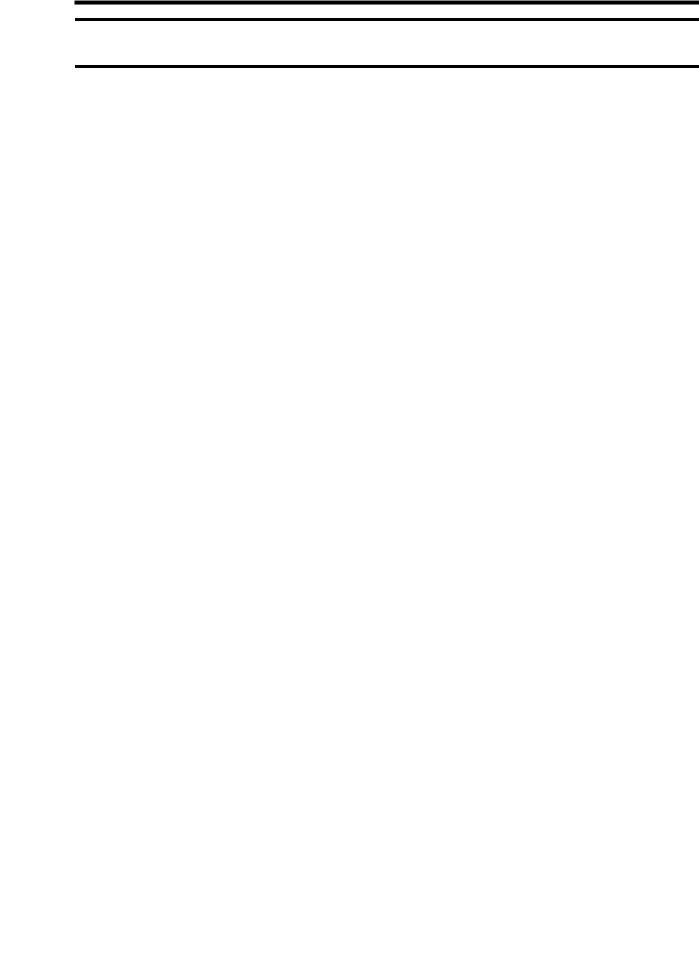
About This Manual
About This Manual
This User's Manual is compiled chapter by chapter for user's convenience as follows. Understanding the following configuration ensures more effective use of the product.
|
|
Overview |
|
|
|
|
|
Chapter 1 |
Overview |
Describes features and names of parts. |
|
|
|
|
|
|
|
Provides external dimensions, installation dimensions, peripheral device |
|
Chapter 2 |
Design |
design/selection instructions, and other information necessary for |
|
|
|
design. |
|
|
|
|
|
Chapter 3 |
Operation |
Describes names of parts, the Inverter's operations, including how to use |
|
the keys on the Digital Operator, and the monitor function. |
|||
|
|
||
|
|
|
|
Chapter 4 |
Functions |
Describes the functions of the Inverter. |
|
|
|
|
|
Chapter 5 |
Maintenance |
Describes the causes and their countermeasures if the Inverter fails, |
|
|
Operations |
including the solutions to possible troubles (troubleshooting). |
|
Chapter 6 |
Inspection and |
Describes items for periodic inspection and/or maintenance for the |
|
Maintenance |
Inverter. |
||
|
|
|
|
Chapter 7 |
Specifications |
Provides Inverter specifications, as well as the specifications and |
|
dimensions of peripheral devices. |
|||
|
|
||
|
|
|
|
Appendix |
|
Describes the summarized parameter settings as a reference for users |
|
|
who have used this Inverter and understood the functions. |
||
|
|
||
|
|
|
12
|
|
Contents |
|
|
|
Introduction.............................................................................................. |
1 |
|
Read and Understand This Manual......................................................... |
2 |
|
Safety Precautions .................................................................................. |
5 |
|
Precautions for Safe Use......................................................................... |
7 |
|
Precautions for Correct Use .................................................................... |
8 |
|
Checking Before Unpacking .................................................................... |
10 |
|
Revision History....................................................................................... |
11 |
|
About This Manual................................................................................... |
12 |
|
Chapter 1 |
Overview |
|
1-1 |
Functions ................................................................................................. |
1-1 |
1-2 Appearance and Names of Parts............................................................. |
1-3 |
|
Chapter 2 |
Design |
|
2-1 |
Installation................................................................................................ |
2-1 |
2-2 |
Wiring....................................................................................................... |
2-6 |
Chapter 3 |
Operation |
|
3-1 |
Test Run Procedure................................................................................. |
3-3 |
3-2 |
Test Run Operation ................................................................................. |
3-4 |
3-3 Part Names and Descriptions of the Digital Operator.............................. |
3-9 |
|
3-4 Operation Procedure (Example: Factory Default).................................... |
3-11 |
|
3-5 |
Keys......................................................................................................... |
3-17 |
3-6 |
Parameter Transition ............................................................................... |
3-18 |
3-7 |
Parameter List ......................................................................................... |
3-20 |
Chapter 4 |
Functions |
|
4-1 |
Monitor Mode........................................................................................... |
4-1 |
4-2 |
Function Mode ......................................................................................... |
4-5 |
Chapter 5 |
Maintenance Operations |
|
5-1 |
Special Display List.................................................................................. |
5-1 |
5-2 |
Troubleshooting ....................................................................................... |
5-5 |
Chapter 6 Inspection and Maintenance |
|
|
6-1 |
Inspection and Maintenance.................................................................... |
6-1 |
6-2 |
Storage .................................................................................................... |
6-7 |
Chapter 7 |
Specifications |
|
7-1 |
Standard Specification List ...................................................................... |
7-1 |
7-2 Measurement Method of Output Voltage................................................. |
7-5 |
|
13

Contents
7-3 |
Connection Example ............................................................................... |
7-6 |
7-4 |
Dimensional Drawing .............................................................................. |
7-8 |
7-5 |
Options.................................................................................................... |
7-14 |
Appendix
Appendix-1 |
Parameter List ................................................................................ |
App-1 |
Appendix-2 |
Product Life Curve.......................................................................... |
App-17 |
Index |
|
|
14
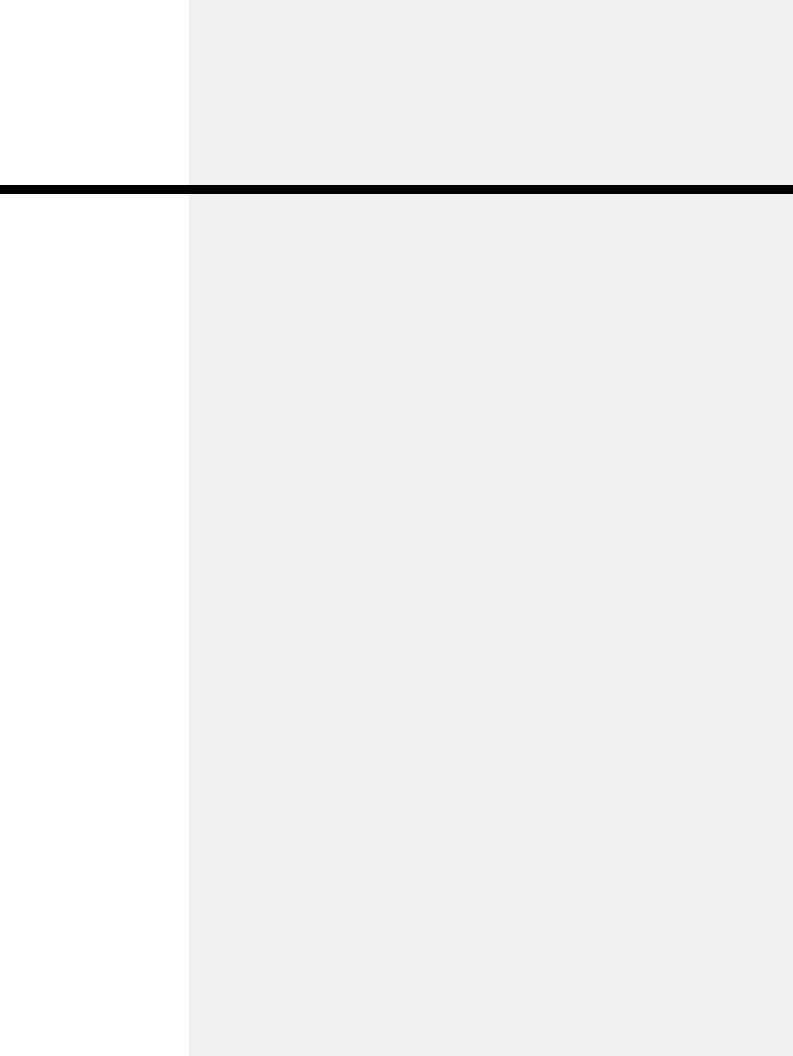
Chapter 1
Overview
1-1 |
Functions .......................................................... |
1-1 |
1-2 |
Appearance and Names of Parts .................... |
1-3 |
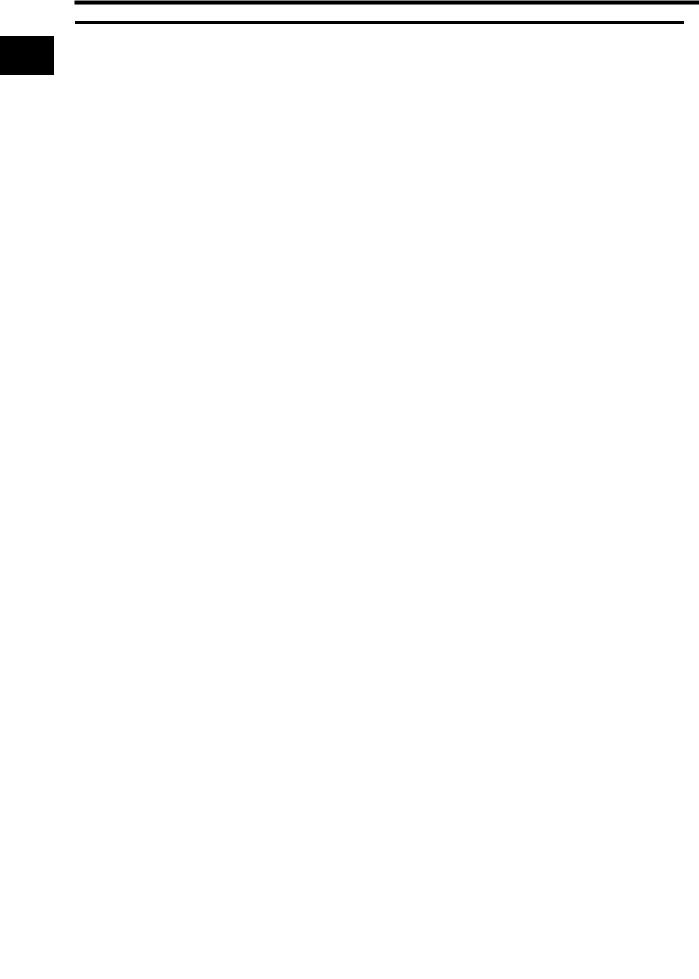
1 Overview
1-1 Functions
1-1 |
Functions |
|
|
|
|
3G3JX Inverter Models |
|
|
|
||
|
|
|
|
|
|
Rated voltage |
Enclosure rating |
Max. applicable motor capacity |
Model |
|
|
|
|
|
|
|
|
|
|
|
0.2 kW |
3G3JX-A2002 |
|
|
|
|
|
|
|
|
|
|
0.4 kW |
3G3JX-A2004 |
|
|
|
|
|
|
|
|
|
|
0.75 kW |
3G3JX-A2007 |
|
|
|
|
|
|
|
3-phase 200 V AC |
|
1.5 kW |
3G3JX-A2015 |
|
|
|
|
|
|
||
|
2.2 kW |
3G3JX-A2022 |
|
||
|
|
|
|
||
|
|
|
|
|
|
|
|
|
3.7 kW |
3G3JX-A2037 |
|
|
|
|
|
|
|
|
|
|
5.5 kW |
3G3JX-A2055 |
|
|
|
|
|
|
|
|
|
|
7.5 kW |
3G3JX-A2075 |
|
|
|
|
|
|
|
|
|
|
0.4 kW |
3G3JX-A4004 |
|
|
|
IP20 |
|
|
|
|
|
0.75 kW |
3G3JX-A4007 |
|
|
|
|
(Complies with |
|
|
|
|
|
1.5 kW |
3G3JX-A4015 |
|
|
|
|
JEM1030) |
|
||
|
|
|
|
|
|
3-phase 400 V AC |
|
2.2 kW |
3G3JX-A4022 |
|
|
|
|
|
|
|
|
|
|
|
3.7 kW |
3G3JX-A4037 |
|
|
|
|
|
|
|
|
|
|
5.5 kW |
3G3JX-A4055 |
|
|
|
|
|
|
|
|
|
|
7.5 kW |
3G3JX-A4075 |
|
|
|
|
|
|
|
|
|
|
0.2 kW |
3G3JX-AE002 |
|
|
|
|
|
|
|
|
|
|
0.4 kW |
3G3JX-AE004 |
|
1/3-phase 200 V AC |
|
|
|
|
|
|
0.75 kW |
3G3JX-AE007 |
|
||
|
|
|
|
|
|
|
|
|
1.5 kW |
3G3JX-AE015 |
|
|
|
|
|
|
|
|
|
|
2.2 kW |
3G3JX-AE022 |
|
|
|
|
|
|
|
International Standards Models (EC Directives and UL/cUL Standards)
The 3G3JX Inverter meets the EC Directives and UL/cUL standard requirements for worldwide use.
Classification |
Applicable standard |
||
|
|
|
|
EC Directives |
EMC Directive |
EN61800-3: 2004 |
|
|
|
||
Low-voltage Directive |
EN61800-5-1: 2003 |
||
|
|||
|
|
|
|
UL/cUL Standards |
UL508C |
||
|
|
|
|
1-1

1-1 Functions
Compact Simplified Inverter for Customer's Environment and Application Demands
Simple Wiring and Easy Installation
The main circuit adopts upper/lower wiring as with a conductor. In addition, the side-by-side mounting of the Inverters and the built-in zero-phase reactor contribute to space saving in control panel.
Wide Ranging Capacity and Power Supply
In spite of its compact size, the 3G3JX Inverter provides a wide ranging capacity from 0.2 to 7.5 kW. Moreover, the three-phase 200 V, three-phase 400 V, and single/three-phase 200 V common types are made to meet the power supply specifications for use outside Japan.
PID Function
The PID function is featured for the easier control of the fan and pump. It helps to control airflow and pressure.
Emergency Shutoff Function
Switching the dedicated switch (S8) changes from the multi-function input (input 3) to the emergency shutoff input. You can directly turn off a motor control power module without operating the software.
Compliance With All Standards
The 3G3JX Series has achieved compliance with CE and UL/cUL.
The RoHS Directive
The standard model meets the requirements of the RoHS Directive.
Noise and Harmonics Suppression Option
The three-phase models incorporate a zero-phase reactor (radio noise filter) as a standard specification.
For the single/three-phase common type, optional suppression is available.
When the optional DC reactor is added, the 3G3JX Series will also meet the requirements specified by the Ministry of Land, Infrastructure, Transport and Tourism of Japan.
Handles a Variety of I/O Signals
The 3G3JX Series can handle a variety of I/O signals for wide-ranging applications. •Analog voltage input: 0 to 10 V
•Analog current input: 4 to 20 mA
1 Overview
1-2
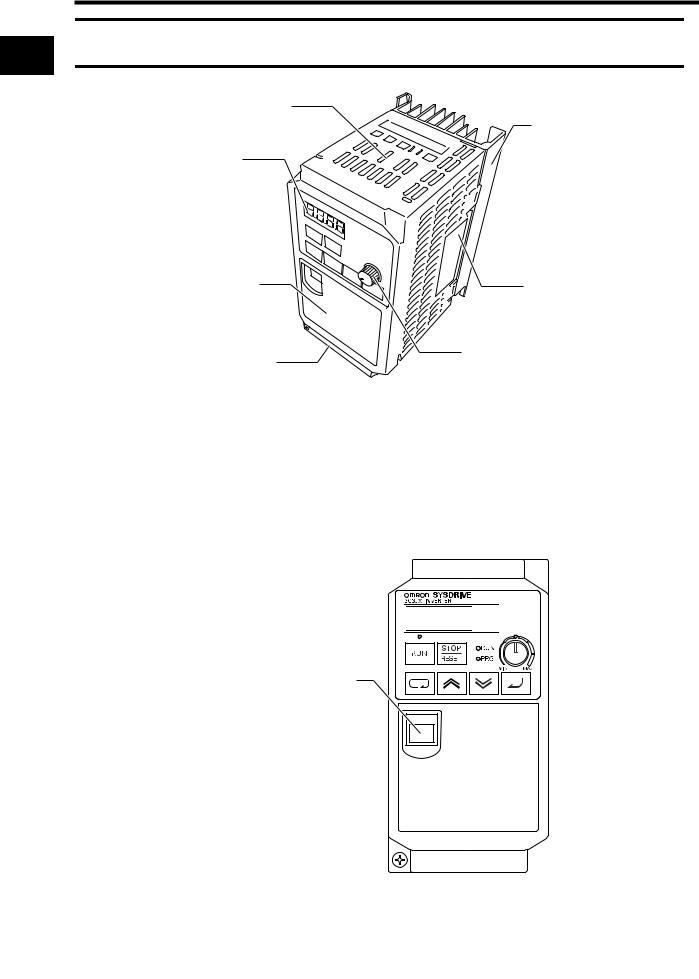
1-2 Appearance and Names of Parts
1 1-2 Appearance and Names of Parts
Overview
Top cover
Fin
Digital Operator
Front cover |
Main housing |
|
|
|
FREQ (FREQUENCY) adjuster |
Bottom cover |
|
•The size of the fin varies with the motor capacity.
•There are two sizes depending on the motor capacity, but the fundamental structure is the same. •Remove the front cover when connecting the power supply, the motor, and the control signal.
Connection to RJ45 Jack
Connect the communications cable after opening the cover of the communications connector. Remove the front cover to switch communications. Refer to "Removing the Front Cover" (page 2- 6) for instructions on how to remove the front cover.

 8k8k8k8
8k8k8k8






Communications connector (with cover)
*The cover of the communications connector is removable. Remove the front cover to attach it.
1-3
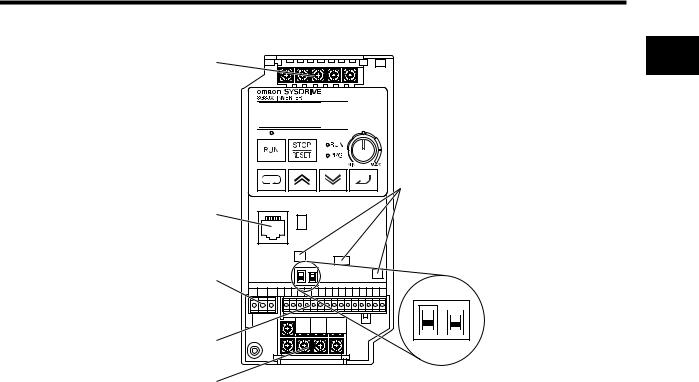
1-2 Appearance and Names of Parts
Names of Parts Inside the Front Cover
Main circuit terminal block (input side)

 8k8k8k8
8k8k8k8






|
Do not touch these! |
|
(ELECTRICAL HAZARD: |
Communications connector |
For factory maintenance only) |
|
Relay output terminal block
S7 S8
485 
 ON
ON
OPE 
 OFF
OFF
Control circuit terminal block
Main circuit terminal block (output side)
S7: OPE/485 communications selector (Default = OPE side)
S8: Emergency shutoff function selector (Default = OFF)
(Caution)
Do not switch the emergency shutoff function selector (S8) without reason as the allocation of the multi-function input terminals may change.
For details, refer to "Emergency Shutoff Input Function" (page 4-45).
1 Overview
1-4

1-2 Appearance and Names of Parts
1 Overview
1-5

Chapter 2
Design
2-1 |
Installation ........................................................ |
2-1 |
2-2 |
Wiring ................................................................ |
2-6 |
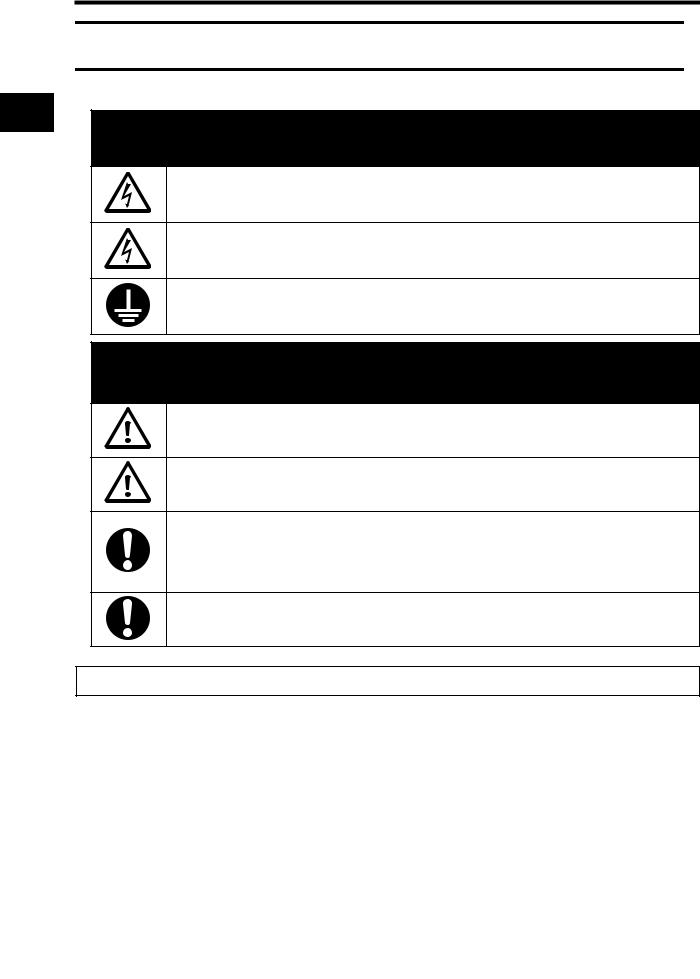
2 Design
2-1 Installation
2-1 Installation
 WARNING
WARNING
Turn off the power supply and implement wiring correctly. Not doing so may result in a serious injury due to an electric shock.
Wiring work must be carried out only by qualified personnel. Not doing so may result in a serious injury due to an electric shock.
Be sure to ground the unit. Not doing so may result in a serious injury due to an electric shock or fire. (200-V class: type-D grounding, 400-V class: type-C grounding)
 CAUTION
CAUTION
Do not connect resistors to the terminals (+1, P/+2, N/-) directly.
Doing so might result in a small-scale fire, heat generation or damage to the unit.
Install a stop motion device to ensure safety. Not doing so might result in a minor injury. (A holding brake is not a stop motion device designed to ensure safety.)
Be sure to use a specified type of braking resistor/regenerative braking unit. In case of a braking resistor, install a thermal relay that monitors the temperature of the resistor. Not doing so might result in a moderate burn due to the heat generated in the braking resistor/regenerative braking unit. Configure a sequence that enables the Inverter power to turn off when unusual overheating is detected in the braking resistor/regenerative braking unit.
The Inverter has high voltage parts inside which, if short-circuited, might cause damage to itself or other property. Place covers on the openings or take other precautions to make sure that no metal objects such as cutting bits or lead wire scraps go inside when installing and wiring.
Safety Information
Installation and Storage
Do not store or use the product in the following places. •Locations subject to direct sunlight.
•Locations subject to ambient temperature exceeding the specifications. •Locations subject to relative humidity exceeding the specifications. •Locations subject to condensation due to severe temperature fluctuations. •Locations subject to corrosive or flammable gases.
•Locations subject to exposure to combustibles. •Locations subject to dust (especially iron dust) or salts. •Locations subject to exposure to water, oil, or chemicals. •Locations subject to shock or vibration.
2-1
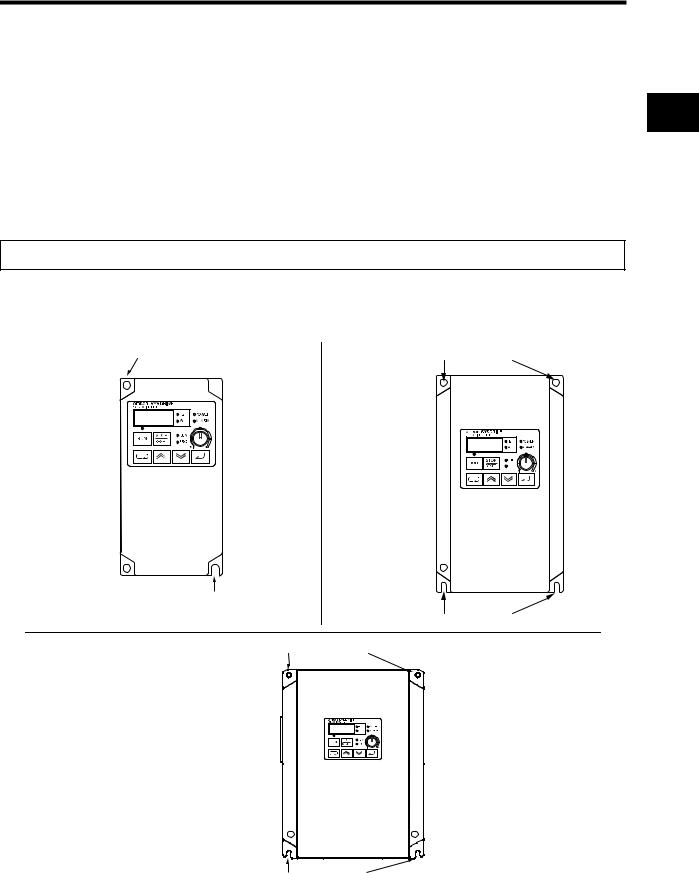
2-1 Installation
Transporting, Installation, and Wiring
•Do not drop or apply strong impact on the product. Doing so may result in damaged parts or malfunction. •Do not hold by the front cover, but hold by the fins during transportation.
•Do not connect an AC power supply voltage to the control input/output terminals. Doing so may result in damage to the product.
•Be sure to tighten the screws on the terminal block securely. Wiring work must be done after installing the unit body.
•Do not connect any load other than a three-phase inductive motor to the U, V, and W output terminals. •Take sufficient shielding measures when using the product in the following locations. Not doing so may result in damage to the product.
Locations subject to static electricity or other forms of noise. Locations subject to strong magnetic fields.
Locations close to power lines.
Precautions for Use
Installation
•Install the Inverter vertically on the wall or DIN tracks (optional).
Install the Inverter on a nonflammable wall surface material, like metal.
|
Position for installing a screw |
Model |
Positions for installing screws |
Model |
|
|
|
|
3G3JX-A2015 |
|
|
3G3JX-A2002 |
|
|
|
|
A2022 |
|
|
A2004 |
|
|
|
|
A2037 |
|
|
A2007 |
|
|
|
|
A4004 |
|
|
AE002 |
|
|
|
|
A4007 |
|
|
AE004 |
|
|
|
|
A4015 |
|
|
|
|
|
|
|
|
A4022 |
|
|
|
A4037 |
|
|
|
AE007 |
|
|
|
AE015 |
|
|
|
AE022 |
|
Screw size for |
|
Screw size for |
|
installation: M5 |
|
|
|
|
installation: M5 |
|
|
|
Position for installing a screw |
|
|
|
|
|
|
|
|
|
Positions for installing screws |
|
Position for installing a screw |
|
|
|
Model |
|
|
|
3G3JX-A2055 |
|
|
|
-A2075 |
|
|
|
-A4055 |
|
|
|
-A4075 |
|
|
Screw size for installation: M6
Position for installing a screw
2 Design
2-2
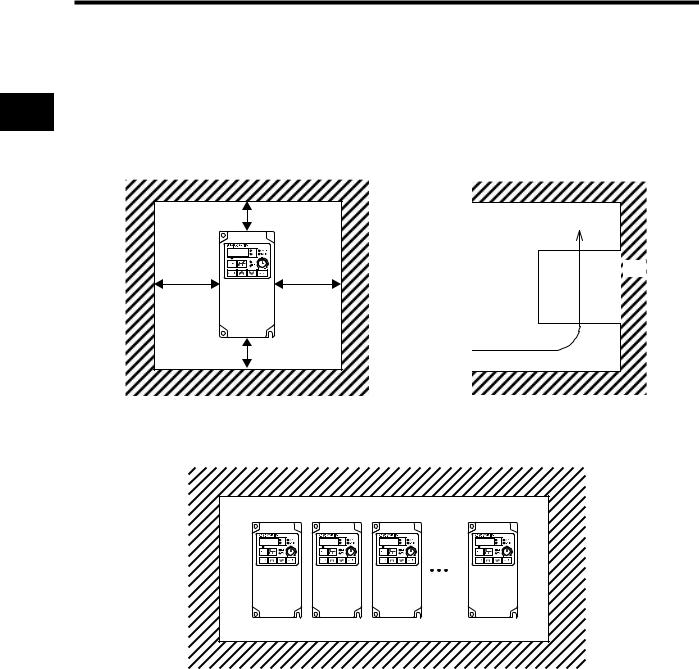
2 Design
2-1 Installation
Main Circuit Power Supply
•Confirm that the rated input voltage of the Inverter matches the AC power supply voltage.
Installation Environment
•Increased ambient temperatures will shorten the life of the Inverter.
•Keep the Inverter away from heating elements (such as a braking resistor, DC reactor, etc.).
If the Inverter is installed in a control panel, keep the ambient temperature within the range of the specifications, taking dimensions and ventilation into consideration.
|
10 cm min. |
Airflow |
|
|
|
|
|
Wall |
5 cm min. |
5 cm min. |
|
|
10 cm min. |
|
•You can install multiple 3G3JX Inverters side by side in the control panel (side-by-side installation). Again, keep the ambient temperature within the specified range (40°C or below).
•If the ambient temperature is from 40°C through to 50°C, the carrier frequency should be reduced and the Inverter capacity should be increased.
2-3
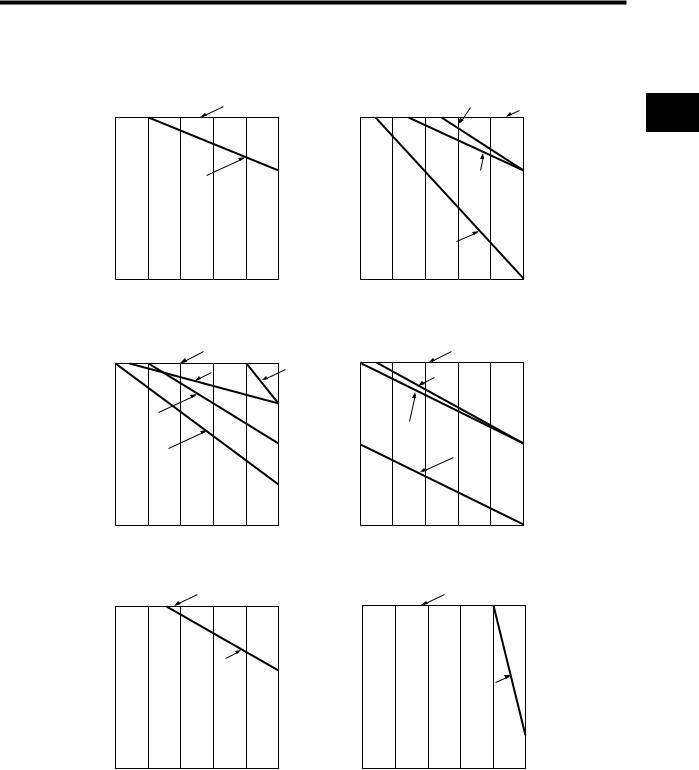
2-1 Installation
•To raise the carrier frequency, reduce the output current (or derate the rated current) as shown in the graph below.
(1) Side-By-Side installation (ambient temperature:40°C)
|
|
200-V Class |
|
|
|
|
|
0.2 to 2.2 · 5.5/7.5kW |
|
|
400-V Class |
|
|
|
0.4 to 2.2kW |
5.5/kW |
|||||||||||||||
|
|
|
|
|
|
|
|
|
|
|
|
|
|
|
|
|
|||||||||||||||
|
100% |
|
|
|
|
|
|
|
|
|
|
|
|
|
|
|
100% |
|
|
|
|
|
|
|
|
|
|
|
|
||
%) |
|
|
|
|
|
|
|
|
|
|
|
|
|
|
%) |
|
|
|
|
|
|
|
|
|
|
|
|
|
|
||
|
|
|
|
|
|
|
|
|
|
|
|
|
|
|
|
|
|
|
|
|
|
|
|
|
|
|
|
||||
|
|
|
|
|
|
|
|
|
|
|
|
|
|
|
|
|
|
|
|
|
|
|
|
|
|
|
|
|
|
||
current |
95% |
|
|
|
|
|
|
|
|
|
|
|
|
|
|
current |
95% |
|
|
|
|
|
|
|
|
|
|
|
|
|
|
|
|
|
|
|
|
|
|
|
|
|
|
|
|
|
|
|
|
|
|
|
|
|
|
|
|
|
|
||||
90% |
|
|
|
|
|
|
|
|
|
|
|
|
|
|
90% |
|
|
|
|
|
|
|
|
|
|
|
|
|
|
||
(Rated |
85% |
|
|
|
|
|
|
3.7 kW |
|
|
|
|
|
(Rated |
85% |
|
|
|
|
|
|
|
|
|
7.5kW |
|
|
||||
|
|
|
|
|
|
|
|
|
|
|
|
|
|
|
|
|
|
|
|
|
|
|
|
|
|
||||||
|
|
|
|
|
|
|
|
|
|
|
|
|
|
|
|
|
|
|
|
|
|
|
|
|
|
|
|
|
|||
current |
80% |
|
|
|
|
|
|
|
|
|
|
|
|
|
|
current |
80% |
|
|
|
|
|
|
|
|
|
|
|
|
|
|
|
|
|
|
|
|
|
|
|
|
|
|
|
|
|
|
|
|
|
|
|
|
|
|
|
|
|
|
||||
Output |
|
|
|
|
|
|
|
|
|
|
|
|
|
|
Output |
|
|
|
|
|
|
3.7kW |
|
|
|
|
|
||||
|
|
|
|
|
|
|
|
|
|
|
|
|
|
|
|
|
|
|
|
|
|
|
|
|
|
|
|||||
|
|
|
|
|
|
|
|
|
|
|
|
|
|
|
|
|
|
|
|
|
|
|
|
|
|
|
|
|
|||
|
75% |
|
|
|
|
|
|
|
|
|
|
|
|
|
|
|
75% |
|
|
|
|
|
|
|
|
|
|
|
|
|
|
|
|
|
|
|
|
|
|
|
|
|
|
|
|
|
|
|
|
|
|
|
|
|
|
|
|
|
|
|
|
||
|
70% |
|
|
|
|
|
|
|
|
|
|
|
|
|
|
|
70% |
|
|
|
|
|
|
|
|
|
|
|
|
|
|
|
|
|
|
|
|
|
|
|
|
|
|
|
|
|
|
|
|
|
|
|
|
|
|
|
|
|
|
|
|
||
|
|
|
|
|
|
|
|
|
|
|
|
|
|
|
|
|
|
|
|
|
|
|
|
|
|
|
|
|
|
||
|
2 |
4 |
|
6 |
8 |
10 |
12 |
|
2 |
4 |
|
6 |
8 |
10 |
12 |
||||||||||||||||
|
|
|
|
Carrier frequency [kHz] |
|
|
|
|
|
|
Carrier frequency [kHz] |
|
|
||||||||||||||||||
(2) Ambient temperature 50°C
|
|
200-V Class |
|
|
0.2/0.4/2.2/5.5kW |
|
|
400-V Class |
|
|
|
5.5kW |
|
|
|
|
|
|||||||||||||||
|
100% |
|
|
|
|
|
|
|
|
|
|
|
|
1.5kW |
|
100% |
|
|
|
|
|
|
|
|
|
|
|
|
|
|
|
|
%) |
|
|
|
|
|
|
|
|
7.5kW |
|
%) |
|
|
|
|
|
|
|
|
|
|
|
|
|
|
|
|
|||||
|
|
|
|
|
|
|
|
|
|
|
|
|
|
|
|
|
|
|
|
|
|
|
|
|
|
|
||||||
|
|
|
|
|
|
|
|
|
|
|
|
|
|
|
|
|
|
|
0.4 to 1.5/7.5kW |
|
|
|
||||||||||
95% |
|
|
|
|
|
|
|
|
|
|
|
|
|
95% |
|
|
|
|
|
|
|
|
|
|
||||||||
current |
|
|
|
|
|
|
|
|
|
|
|
|
|
current |
|
|
|
|
|
|
|
|
|
|
|
|
|
|
|
|
||
90% |
|
|
|
|
|
|
|
|
|
|
|
|
|
90% |
|
|
|
|
|
|
|
|
|
|
|
|
|
|
|
|
||
(Rated |
|
0.75kW |
|
|
|
|
|
|
|
|
(Rated |
|
|
|
|
|
|
|
|
|
|
|
|
|
|
|
|
|||||
|
|
|
|
|
|
|
|
|
|
|
|
|
|
|
|
|
|
|
|
|
|
|
|
|
|
|
||||||
85% |
|
|
|
|
|
|
|
|
|
|
|
|
|
85% |
|
|
|
|
|
|
|
|
|
|
|
|
|
|
|
|
||
|
|
|
|
|
|
|
|
|
|
|
|
|
|
|
|
|
|
2.2kW |
|
|
|
|
|
|
|
|
|
|
|
|||
|
|
|
|
|
|
|
|
|
|
|
|
|
|
|
|
|
|
|
|
|
|
|
|
|
|
|
|
|
|
|
||
current |
80% |
|
|
|
|
|
|
|
|
|
|
|
|
|
current |
80% |
|
|
|
|
|
|
|
|
|
|
|
|
|
|
|
|
|
|
3.7kW |
|
|
|
|
|
|
|
|
|
|
|
|
|
|
|
|
3.7kW |
|
|
|
|
|
||||||||
|
|
|
|
|
|
|
|
|
|
|
|
|
|
|
|
|
|
|
|
|
|
|
|
|
||||||||
|
|
|
|
|
|
|
|
|
|
|
|
|
|
|
|
|
|
|
|
|
|
|
|
|
|
|
||||||
|
75% |
|
|
|
|
|
|
|
|
|
|
|
|
|
|
75% |
|
|
|
|
|
|
|
|
|
|
|
|
|
|||
Output |
|
|
|
|
|
|
|
|
|
|
|
|
|
Output |
|
|
|
|
|
|
|
|
|
|
|
|
|
|
|
|
||
|
|
|
|
|
|
|
|
|
|
|
|
|
|
|
|
|
|
|
|
|
|
|
|
|
|
|
|
|
||||
65% |
|
|
|
|
|
|
|
|
|
|
|
|
|
65% |
|
|
|
|
|
|
|
|
|
|
|
|
|
|
|
|
||
|
70% |
|
|
|
|
|
|
|
|
|
|
|
|
|
|
70% |
|
|
|
|
|
|
|
|
|
|
|
|
|
|
|
|
|
60% |
|
|
|
|
|
|
|
|
|
|
|
|
|
|
60% |
|
|
|
|
|
|
|
|
|
|
|
|
|
|
|
|
|
|
|
|
|
|
|
|
|
|
|
|
|
|
|
|
|
|
|
|
|
|
|
|
|
|
|
|
|
|
|
||
|
|
|
|
|
|
|
|
|
|
|
|
|
|
|
|
|
|
|
|
|
|
|
|
|
|
|
|
|
|
|
||
|
2 |
4 |
|
6 |
8 |
10 |
12 |
|
2 |
4 |
|
|
6 |
|
8 |
|
10 |
12 |
||||||||||||||
|
|
|
|
|
Carrier frequency [kHz] |
|
|
|
|
|
|
|
Carrier frequency [kHz] |
|
|
|
||||||||||||||||
(3) Ambient temperature 40°C |
|
|
|
|
|
|
|
|
|
|
|
|
|
|
|
|
|
|
|
|
|
|
||||||||||
|
|
200-V Class |
|
|
0.2 to 2.2 · 5.5/7.5kW |
|
|
|
400-V Class |
|
|
|
0.4 to 2.2 · 5.5/7.5kW |
|||||||||||||||||||
%) |
100% |
|
|
|
|
|
|
|
|
|
|
|
|
|
%) |
100% |
|
|
|
|
|
|
|
|
|
|
|
|
|
|
|
|
|
|
|
|
|
|
|
|
|
|
|
|
|
|
|
|
|
|
|
|
|
|
|
|
|
|
|
|
|||||
|
|
|
|
|
|
|
|
|
|
|
|
|
|
|
|
|
|
|
|
|
|
|
|
|
|
|
|
|
|
|
||
current |
95% |
|
|
|
|
|
|
|
|
|
|
|
|
|
current |
95% |
|
|
|
|
|
|
|
|
|
|
|
|
|
|
|
|
(Rated |
|
|
|
|
|
|
|
3.7kW |
|
|
|
|
(Rated |
|
|
|
|
|
|
|
|
|
|
|
|
|
|
|
|
|||
|
|
|
|
|
|
|
|
|
|
|
|
|
|
|
|
|
|
|
|
|
|
|
|
|
|
|
|
|
||||
90% |
|
|
|
|
|
|
|
|
|
|
|
|
|
90% |
|
|
|
|
|
|
|
|
|
|
|
|
|
|
|
|
||
current |
|
|
|
|
|
|
|
|
|
|
|
|
|
current |
|
|
|
|
|
|
|
|
|
3.7kW |
|
|
|
|||||
|
|
|
|
|
|
|
|
|
|
|
|
|
|
|
|
|
|
|
|
|
|
|
|
|
|
|
||||||
85% |
|
|
|
|
|
|
|
|
|
|
|
|
|
85% |
|
|
|
|
|
|
|
|
|
|
|
|
|
|
|
|
||
Output |
|
|
|
|
|
|
|
|
|
|
|
|
|
Output |
|
|
|
|
|
|
|
|
|
|
|
|
|
|
|
|
||
80% |
|
|
|
|
|
|
|
|
|
|
|
|
|
80% |
|
|
|
|
|
|
|
|
|
|
|
|
|
|
|
|
||
|
|
|
|
|
|
|
|
|
|
|
|
|
|
|
|
|
|
|
|
|
|
|
|
|
|
|
|
|
|
|
||
|
75% |
|
|
|
|
|
|
|
|
|
|
|
|
|
|
75% |
|
|
|
|
|
|
|
|
|
|
|
|
|
|
|
|
|
|
|
|
|
|
|
|
|
|
|
|
|
|
|
|
|
|
|
|
|
|
|
|
|
|
|
|
|
|
|
||
|
|
|
|
|
|
|
|
|
|
|
|
|
|
|
|
|
|
|
|
|
|
|
|
|
|
|
|
|
|
|||
|
2 |
4 |
|
6 |
8 |
10 |
12 |
|
2 |
4 |
|
6 |
8 |
|
10 |
12 |
||||||||||||||||
|
|
|
|
|
Carrier frequency [kHz] |
|
|
|
|
|
|
|
Carrier frequency [kHz] |
|
|
|
||||||||||||||||
2 Design
2-4
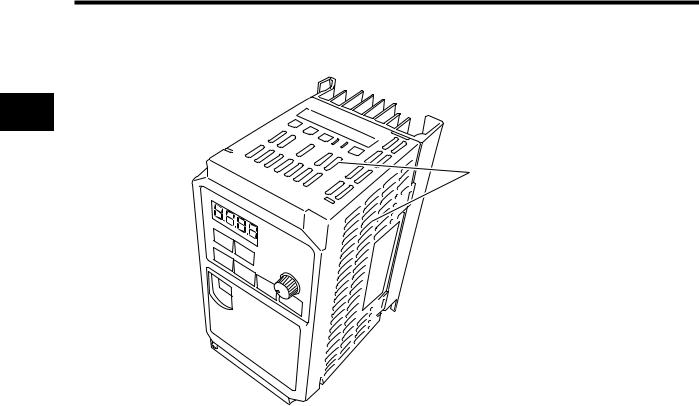
2 Design
2-1 Installation
•Before installing the Inverter, place a cover over all the ventilation openings to shield them from foreign objects.
After completing the installation process, be sure to remove the covers from the Inverter before operation.
Ventilation openings (Both sides and top)
2-5
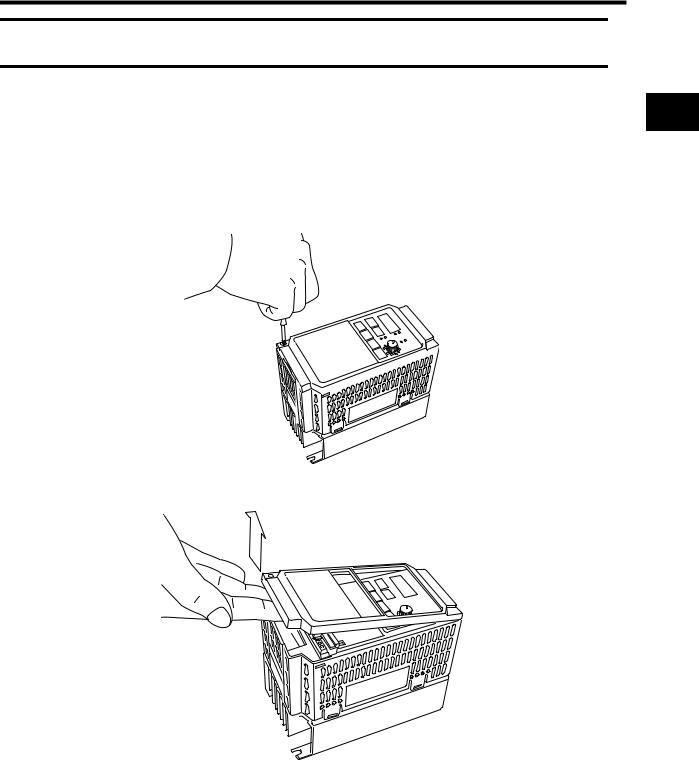
2-2 Wiring
2-2 Wiring
Removing and Mounting the Front Cover
Removing the Front Cover
Loosen the mounting screw at the lower left of the front cover. Lift the bottom of the front cover to remove while holding the body.
1. Loosen the front cover mounting screw.
2. Lift the bottom of the front cover to remove.
2 Design
2-6
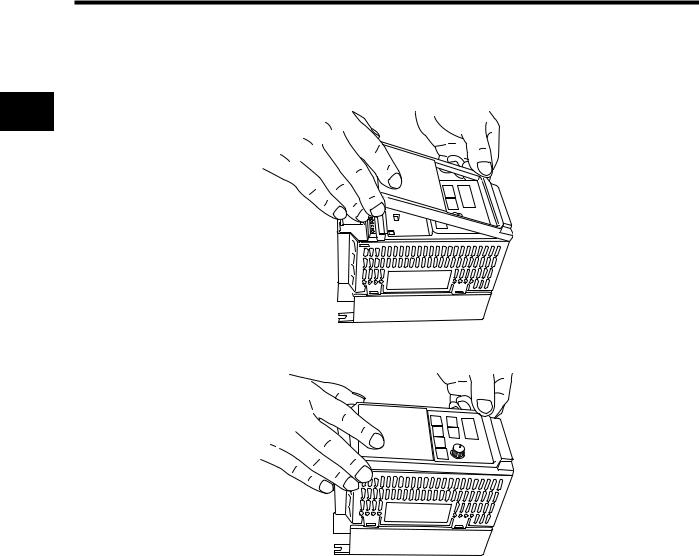
2-2 Wiring
Mounting the Front Cover
Hang the upper side of the front cover on the hooks, and push down both sides of the cover simultaneously until it clicks into place.
1. Hang the upper side on the hooks. (Two hooks)
2 Design
2. Push down the cover until it clicks into place. (Both sides)
2-7
